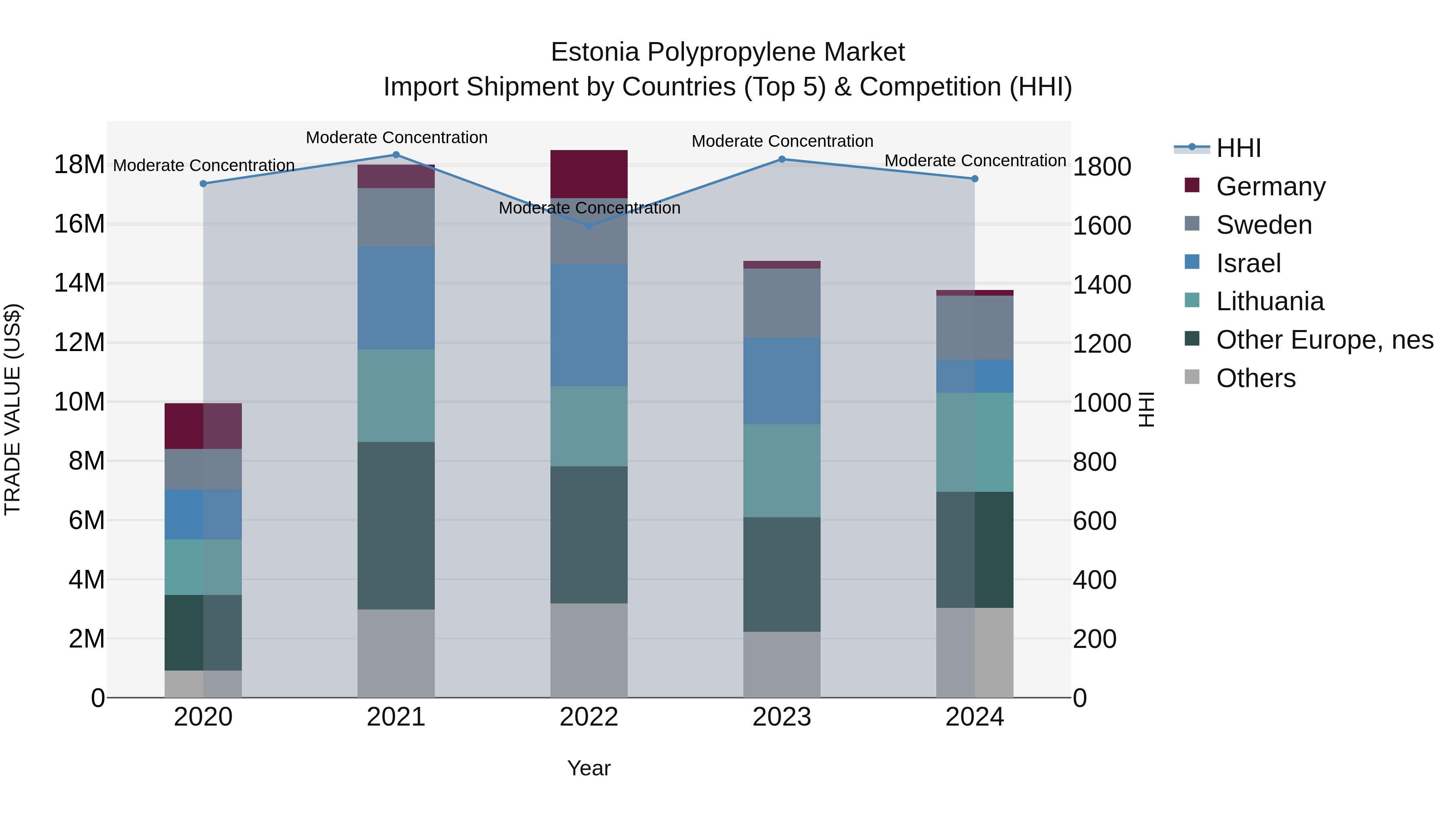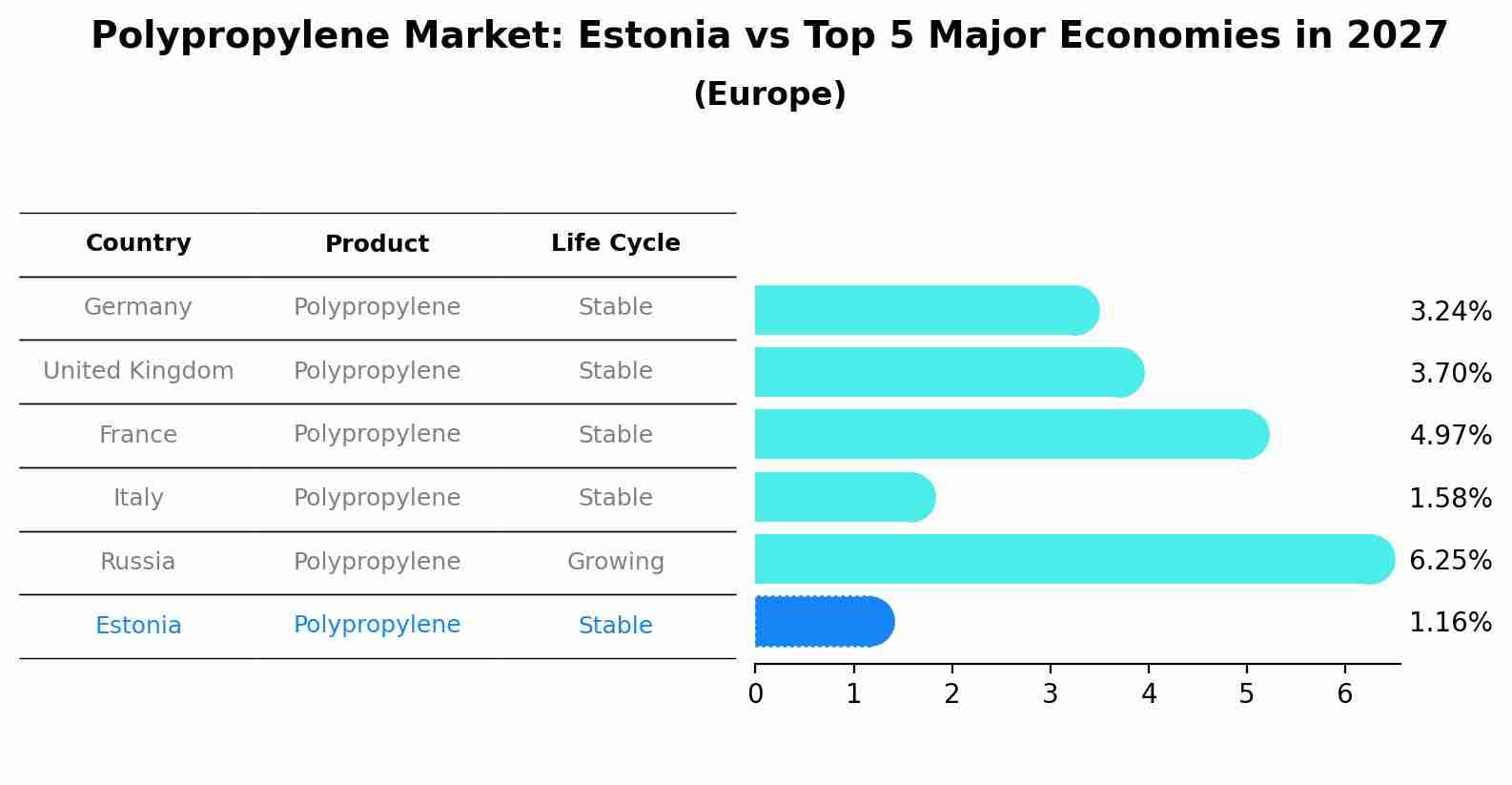Estonia Polypropylene Market (2025-2031) | Revenue, Share, Outlook, Trends, Size, Analysis, Forecast, Growth, Segmentation, Value, Companies & Industry
| Product Code: ETC5054431 | Publication Date: Nov 2023 | Updated Date: Nov 2025 | Product Type: Market Research Report | |
| Publisher: 6Wresearch | Author: Sachin Kumar Rai | No. of Pages: 60 | No. of Figures: 30 | No. of Tables: 5 |
Estonia Polypropylene Market Top 5 Importing Countries and Market Competition (HHI) Analysis
In 2024, Estonia saw a steady flow of polypropylene import shipments primarily coming from various European countries such as Lithuania, Sweden, and Other Europe. The moderate concentration level indicated by the Herfindahl-Hirschman Index (HHI) suggests a competitive market landscape. Despite a slightly negative growth rate from 2023 to 2024, the compound annual growth rate (CAGR) over the four-year period remained strong at 8.48%. Estonia`s reliance on imports from diverse sources like Israel and Vietnam reflects a well-diversified supply chain for polypropylene.

Polypropylene Market: Estonia vs Top 5 Major Economies in 2027 (Europe)
Estonia's Polypropylene market is anticipated to experience a stable growth rate of 1.16% by 2027, reflecting trends observed in the largest economy Germany, followed by United Kingdom, France, Italy and Russia.

Estonia Polypropylene Market Overview
The polypropylene market in Estonia is experiencing growth driven by its widespread use in packaging, textiles, automotive, and consumer goods. Polypropylene is known for its low cost, versatility, and resistance to heat and chemicals. As industries seek more efficient and eco-friendly materials, polypropylenes role as a primary material in manufacturing processes continues to increase. Additionally, the growing demand for sustainable packaging solutions is also contributing to the expansion of the polypropylene market in Estonia.
Drivers of the market
Polypropylene (PP) is one of the most widely used plastics in Estonia, particularly in packaging, automotive, and textiles. The market for polypropylene is driven by its versatility, low cost, and recyclability. As demand for eco-friendly and recyclable products increases, the polypropylene market in Estonia is expected to grow.
Challenges of the market
The polypropylene market in Estonia faces multiple challenges, including price fluctuations in raw materials, technological advancements, and environmental concerns. Polypropylene, a widely used thermoplastic, has various applications in packaging, automotive, and textiles. However, rising raw material costs, primarily due to the volatility in oil prices, can significantly affect profitability. Furthermore, the market is experiencing pressure from sustainability demands, as polypropylene, like many other plastics, is often criticized for its environmental impact. Recycling challenges and the limited biodegradability of polypropylene are significant hurdles for the industry. Moreover, manufacturers must keep up with rapid technological advancements to improve product quality and meet changing consumer preferences for eco-friendly materials.
Government Policy of the market
The polypropylene market in Estonia is influenced by government policies aimed at promoting the use of polypropylene in applications such as packaging, textiles, and automotive components. The government supports innovation in polypropylene production, focusing on improving material properties and reducing environmental impact. Estonia also encourages the use of recycled polypropylene to promote sustainability.
Key Highlights of the Report:
- Estonia Polypropylene Market Outlook
- Market Size of Estonia Polypropylene Market, 2024
- Forecast of Estonia Polypropylene Market, 2031
- Historical Data and Forecast of Estonia Polypropylene Revenues & Volume for the Period 2021-2031
- Estonia Polypropylene Market Trend Evolution
- Estonia Polypropylene Market Drivers and Challenges
- Estonia Polypropylene Price Trends
- Estonia Polypropylene Porter`s Five Forces
- Estonia Polypropylene Industry Life Cycle
- Historical Data and Forecast of Estonia Polypropylene Market Revenues & Volume By Type for the Period 2021-2031
- Historical Data and Forecast of Estonia Polypropylene Market Revenues & Volume By Homopolymer for the Period 2021-2031
- Historical Data and Forecast of Estonia Polypropylene Market Revenues & Volume By Copolymer for the Period 2021-2031
- Historical Data and Forecast of Estonia Polypropylene Market Revenues & Volume By Application for the Period 2021-2031
- Historical Data and Forecast of Estonia Polypropylene Market Revenues & Volume By Injection Molding for the Period 2021-2031
- Historical Data and Forecast of Estonia Polypropylene Market Revenues & Volume By Fiber & Raffia for the Period 2021-2031
- Historical Data and Forecast of Estonia Polypropylene Market Revenues & Volume By Film & Sheet for the Period 2021-2031
- Historical Data and Forecast of Estonia Polypropylene Market Revenues & Volume By Blow Molding for the Period 2021-2031
- Historical Data and Forecast of Estonia Polypropylene Market Revenues & Volume By End-use Industry for the Period 2021-2031
- Historical Data and Forecast of Estonia Polypropylene Market Revenues & Volume By Packaging for the Period 2021-2031
- Historical Data and Forecast of Estonia Polypropylene Market Revenues & Volume By Automotive for the Period 2021-2031
- Historical Data and Forecast of Estonia Polypropylene Market Revenues & Volume By Building & Construction for the Period 2021-2031
- Historical Data and Forecast of Estonia Polypropylene Market Revenues & Volume By Electrical & Electronics for the Period 2021-2031
- Historical Data and Forecast of Estonia Polypropylene Market Revenues & Volume By Medical for the Period 2021-2031
- Estonia Polypropylene Import Export Trade Statistics
- Market Opportunity Assessment By Type
- Market Opportunity Assessment By Application
- Market Opportunity Assessment By End-use Industry
- Estonia Polypropylene Top Companies Market Share
- Estonia Polypropylene Competitive Benchmarking By Technical and Operational Parameters
- Estonia Polypropylene Company Profiles
- Estonia Polypropylene Key Strategic Recommendations
Frequently Asked Questions About the Market Study (FAQs):
1 Executive Summary |
2 Introduction |
2.1 Key Highlights of the Report |
2.2 Report Description |
2.3 Market Scope & Segmentation |
2.4 Research Methodology |
2.5 Assumptions |
3 Estonia Polypropylene Market Overview |
3.1 Estonia Country Macro Economic Indicators |
3.2 Estonia Polypropylene Market Revenues & Volume, 2021 & 2031F |
3.3 Estonia Polypropylene Market - Industry Life Cycle |
3.4 Estonia Polypropylene Market - Porter's Five Forces |
3.5 Estonia Polypropylene Market Revenues & Volume Share, By Type, 2021 & 2031F |
3.6 Estonia Polypropylene Market Revenues & Volume Share, By Application, 2021 & 2031F |
3.7 Estonia Polypropylene Market Revenues & Volume Share, By End-use Industry, 2021 & 2031F |
4 Estonia Polypropylene Market Dynamics |
4.1 Impact Analysis |
4.2 Market Drivers |
4.3 Market Restraints |
5 Estonia Polypropylene Market Trends |
6 Estonia Polypropylene Market Segmentations |
6.1 Estonia Polypropylene Market, By Type |
6.1.1 Overview and Analysis |
6.1.2 Estonia Polypropylene Market Revenues & Volume, By Homopolymer, 2021-2031F |
6.1.3 Estonia Polypropylene Market Revenues & Volume, By Copolymer, 2021-2031F |
6.2 Estonia Polypropylene Market, By Application |
6.2.1 Overview and Analysis |
6.2.2 Estonia Polypropylene Market Revenues & Volume, By Injection Molding, 2021-2031F |
6.2.3 Estonia Polypropylene Market Revenues & Volume, By Fiber & Raffia, 2021-2031F |
6.2.4 Estonia Polypropylene Market Revenues & Volume, By Film & Sheet, 2021-2031F |
6.2.5 Estonia Polypropylene Market Revenues & Volume, By Blow Molding, 2021-2031F |
6.3 Estonia Polypropylene Market, By End-use Industry |
6.3.1 Overview and Analysis |
6.3.2 Estonia Polypropylene Market Revenues & Volume, By Packaging, 2021-2031F |
6.3.3 Estonia Polypropylene Market Revenues & Volume, By Automotive, 2021-2031F |
6.3.4 Estonia Polypropylene Market Revenues & Volume, By Building & Construction, 2021-2031F |
6.3.5 Estonia Polypropylene Market Revenues & Volume, By Electrical & Electronics, 2021-2031F |
6.3.6 Estonia Polypropylene Market Revenues & Volume, By Medical, 2021-2031F |
7 Estonia Polypropylene Market Import-Export Trade Statistics |
7.1 Estonia Polypropylene Market Export to Major Countries |
7.2 Estonia Polypropylene Market Imports from Major Countries |
8 Estonia Polypropylene Market Key Performance Indicators |
9 Estonia Polypropylene Market - Opportunity Assessment |
9.1 Estonia Polypropylene Market Opportunity Assessment, By Type, 2021 & 2031F |
9.2 Estonia Polypropylene Market Opportunity Assessment, By Application, 2021 & 2031F |
9.3 Estonia Polypropylene Market Opportunity Assessment, By End-use Industry, 2021 & 2031F |
10 Estonia Polypropylene Market - Competitive Landscape |
10.1 Estonia Polypropylene Market Revenue Share, By Companies, 2024 |
10.2 Estonia Polypropylene Market Competitive Benchmarking, By Operating and Technical Parameters |
11 Company Profiles |
12 Recommendations | 13 Disclaimer |
- Single User License$ 1,995
- Department License$ 2,400
- Site License$ 3,120
- Global License$ 3,795
Search
Thought Leadership and Analyst Meet
Our Clients
Related Reports
- Germany Breakfast Food Market (2026-2032) | Industry, Share, Growth, Size, Companies, Value, Analysis, Revenue, Trends, Forecast & Outlook
- Australia Briquette Market (2025-2031) | Growth, Size, Revenue, Forecast, Analysis, Trends, Value, Share, Industry & Companies
- Vietnam System Integrator Market (2025-2031) | Size, Companies, Analysis, Industry, Value, Forecast, Growth, Trends, Revenue & Share
- ASEAN and Thailand Brain Health Supplements Market (2025-2031) | Strategy, Consumer Insights, Analysis, Investment Trends, Opportunities, Growth, Size, Share, Industry, Revenue, Segments, Value, Segmentation, Supply, Forecast, Restraints, Outlook, Competition, Drivers, Trends, Demand, Pricing Analysis, Competitive, Strategic Insights, Companies, Challenges
- ASEAN Bearings Market (2025-2031) | Strategy, Consumer Insights, Analysis, Investment Trends, Opportunities, Growth, Size, Share, Industry, Revenue, Segments, Value, Segmentation, Supply, Forecast, Restraints, Outlook, Competition, Drivers, Trends, Demand, Pricing Analysis, Competitive, Strategic Insights, Companies, Challenges
- Europe Flooring Market (2025-2031) | Outlook, Share, Industry, Trends, Forecast, Companies, Revenue, Size, Analysis, Growth & Value
- Saudi Arabia Manlift Market (2025-2031) | Outlook, Size, Growth, Trends, Companies, Industry, Revenue, Value, Share, Forecast & Analysis
- Uganda Excavator, Crane, and Wheel Loaders Market (2025-2031) | Strategy, Consumer Insights, Analysis, Investment Trends, Opportunities, Growth, Size, Share, Industry, Revenue, Segments, Value, Segmentation, Supply, Forecast, Restraints, Outlook, Competition, Drivers, Trends, Demand, Pricing Analysis, Competitive, Strategic Insights, Companies, Challenges
- Rwanda Excavator, Crane, and Wheel Loaders Market (2025-2031) | Strategy, Consumer Insights, Analysis, Investment Trends, Opportunities, Growth, Size, Share, Industry, Revenue, Segments, Value, Segmentation, Supply, Forecast, Restraints, Outlook, Competition, Drivers, Trends, Demand, Pricing Analysis, Competitive, Strategic Insights, Companies, Challenges
- Kenya Excavator, Crane, and Wheel Loaders Market (2025-2031) | Strategy, Consumer Insights, Analysis, Investment Trends, Opportunities, Growth, Size, Share, Industry, Revenue, Segments, Value, Segmentation, Supply, Forecast, Restraints, Outlook, Competition, Drivers, Trends, Demand, Pricing Analysis, Competitive, Strategic Insights, Companies, Challenges
Industry Events and Analyst Meet
Whitepaper
- Middle East & Africa Commercial Security Market Click here to view more.
- Middle East & Africa Fire Safety Systems & Equipment Market Click here to view more.
- GCC Drone Market Click here to view more.
- Middle East Lighting Fixture Market Click here to view more.
- GCC Physical & Perimeter Security Market Click here to view more.
6WResearch In News
- Doha a strategic location for EV manufacturing hub: IPA Qatar
- Demand for luxury TVs surging in the GCC, says Samsung
- Empowering Growth: The Thriving Journey of Bangladesh’s Cable Industry
- Demand for luxury TVs surging in the GCC, says Samsung
- Video call with a traditional healer? Once unthinkable, it’s now common in South Africa
- Intelligent Buildings To Smooth GCC’s Path To Net Zero


















